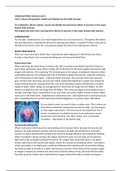Uniformed Public Services Level 3
Unit 5: Physical Preparation, Health and Lifestyle for the Public Services
P3: Undertake a fitness activity, record and identify the short-term effects of exercise on the major
human body systems.
M2: Explain the short-term and long-term effects of exercise on the major human body systems.
INTRODUCTION
For this task, I undertook the 15m multi-stage fitness test, my result was 8.1. Throughout this fitness
test and afterwards, I experienced short-term and long-term effects. I covered P3 when I took part in
the fitness test and to cover M2, I am going to explain the short-term and long-term effects.
SHORT-TERM EFFECTS
There are a few short-term effects that I experienced when taking part in this fitness test, these
include a raised heart rate, increased breathing rate and increased blood flow;
Raised Heart Rate
When exercising, the heart beats at a faster rate, this is to pump more blood around the body at a
much faster speed than usual. When resting, 25% of the blood in the body supplies the muscles with
oxygen and nutrients. The remaining 75% of blood goes to the organs, including the stomach. When
undertaking exercise, this is flipped and 75% of the blood supplies the muscles, while the remaining
25% of blood goes to the organs – mainly the heart and lungs. This is proven when your stomach
goes cold just after exercising, because your blood supply halts digestion to supply more important
organs instead.However, through all of this, your brain will always require and demand a constant
supply of blood. When resting, an average person’s heart rate will range from 60-90bpm. An elite
athlete’s resting heart rate will range from 28-40bpm. This is because highly trained athletes have a
stronger and larger heart, meaning that it can your heart can pump a higher volume of blood. When
I took part in the fitness test, I experienced a raised heart rate. I also experienced a cold stomach just
after completing the test and this had proven that the digestion in my body system had halted.
For our body to work, we need to have a cardiac cycle. This is where our
heart beats and blood is transported around our body; carrying oxygen
to vital organs and muscles. The heart has its own blood flow, this is
known as pulmonary circulation because it uses pulmonary vessels –
also known as the top loop. The other cardiac cycle is systematic
circulation – also known as the bottom loop.
Increased Breathing Rate
When I took part in the fitness test, my breathing rate increased, this is because the muscles and
organs in my body required a greater amount of oxygen. My body also produced an increased
amount of carbon dioxide which needed to be removed through diffusion and released by exhaling.
When I breathed in during running, the oxygen would have gone in to my lungs and would have
taken part in gas exchange locatedat the alveoli. The oxygen then would have been in my blood
stream, delivered to the muscles and organs, mainly the muscles as mentioned above. I was able to
inhale and exhale as my diaphragm would have flattened when exhaling and curved when inhaling.
My body was able to breathe at a faster rate because a person’s brain detects that a greater supply
of oxygen is required to continue the same level of activity without tiring. The brain will also make
the heart pump at a faster rate to distribute the oxygen around the body to muscles and organs.





